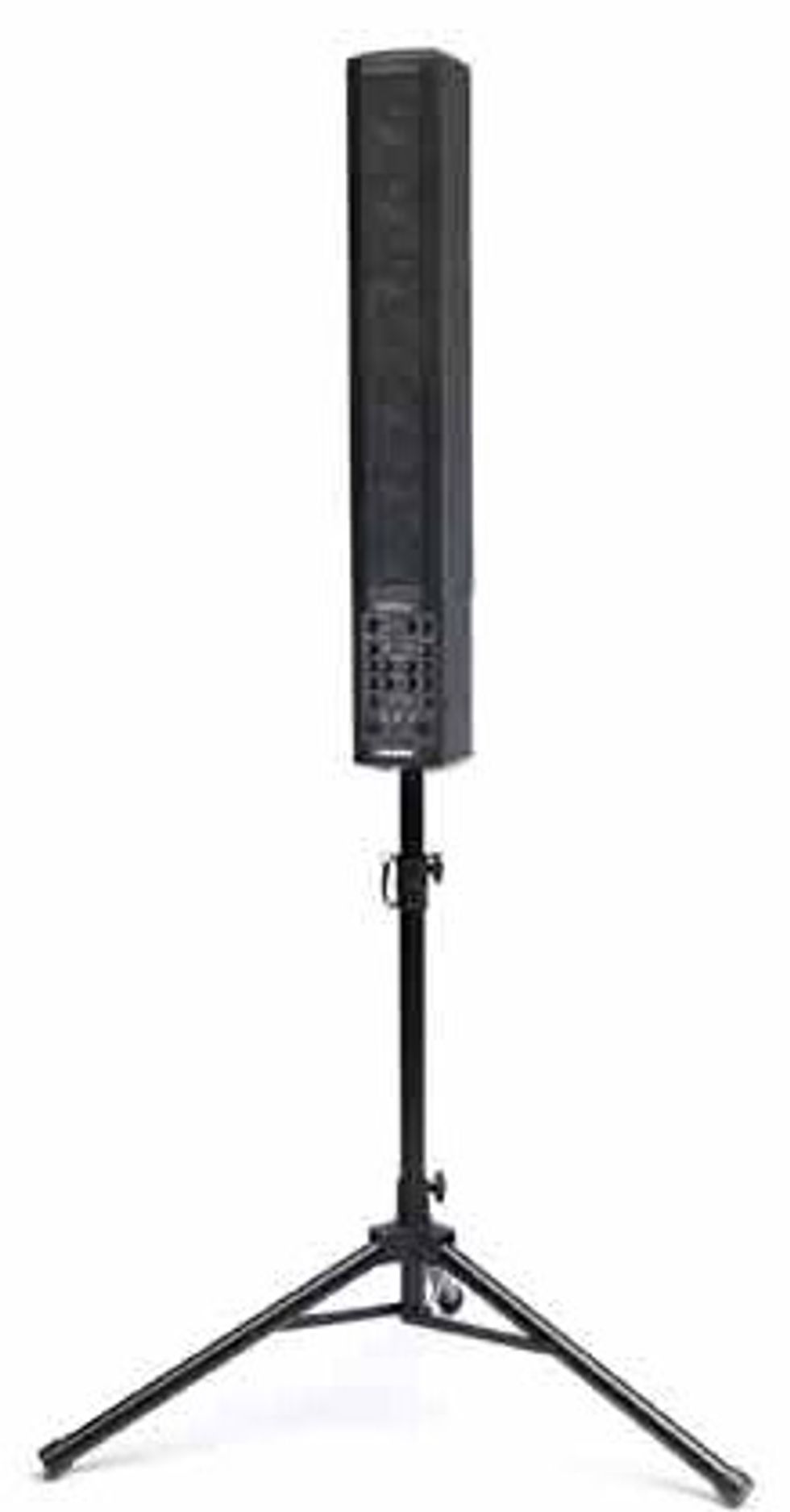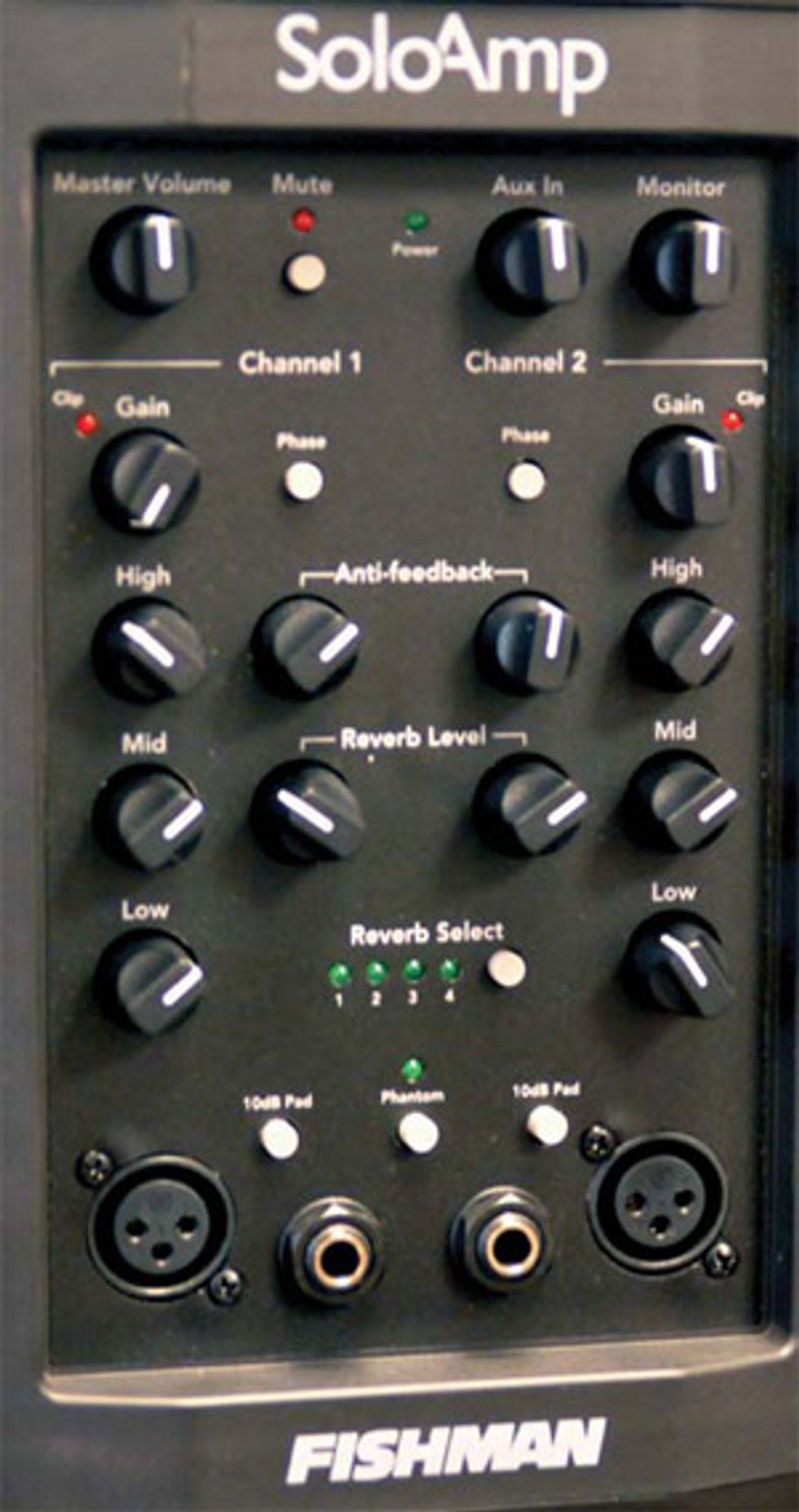The Fishman SoloAmp is a portable, easy-to-use solution for small to mid-sized gigs
 |
| Click to jump to the video review |
Those statements from Fishman’s promotional materials were enough to get my attention. In essence, it’s a product designed specifically for performing singer/songwriters—a truly portable line array system combining everything you’d want at a gig, including sufficient bass, but without the boat anchor sub. With a Summer NAMM 2008 “Best in Show” award under its belt, not to mention the expected comparisons to the Bose L1 system, the SoloAmp comes with high expectations.
Out of the Box
The portability of the SoloAmp is amazing— everything fits in one case, including the speaker stand. Weighing in at 35 pounds altogether, a packed up SoloAmp is 43.5” long, 7” wide and 14.5” high. The case is well-padded and fairly sturdy, with big plastic clips and a thick plastic zipper that seems ready for the rigors of gigging. My only knock on the case is a greedy one—I would have liked an expanded compartment with room for mic and guitar stands, as well. The case’s long shape makes it a bit tippy when trying to roll it with its built-in wheels, but hey, the fact that it has wheels shows Fishman’s commitment to making the gigging musician’s life easier.
The set up is very slick. I tried it once just to get the feel for it, and then I timed myself. On my second try I went from completely cased to totally set up in 55 seconds, and that was with me struggling with the clips on the case a bit—it could’ve been even faster. The speaker stand has markings on it telling you where to set it. You put that on the ground, the amp on the stick, plug it in and you’re done. It really couldn’t be any easier.
 Mission: Controls
Mission: Controls The controls on this amp are great. It is basically a two-channel mixer with very versatile inputs and outputs. Each channel has an XLR or 1/4” input, a gain control, High, Mid, Low EQ, an Anti-Feedback Knob (notch filter), a 10dB pad, a phase switch, a Reverb Level with four different reverbs to choose from, and a button for 48V of Phantom Power. Other controls on the front include a Master Volume, a Monitor and an Aux knob (mp3 or CD player), and a Mute switch.
The Anti-Feedback knob is “Ph.D.” simple (push here, dummy)—you need no knowledge of notch filters or parametric EQs to put it to use. You can reduce low-end rumble or remove a bothersome frequency by playing around with the knob until the feedback is gone or the tone is more pleasing.
The back panel is loaded with output options. Each channel has an effects send and return. There are pre-EQ outputs for each individual channel, allowing you to send clean signals from each channel to separate channels on a front of house mixer or a recording device. There is also a Main Mix DI out, which sends a post-EQ mix of channels 1, 2 and the Aux input. The Mute button does not affect this input, so you can play music on your break. The Aux knob on the front panel controls the level of the Aux Input. The Monitor In/Out allows you to connect two SoloAmps together and hear as much or as little of the other SoloAmp as desired with the Monitor knob on the front panel. There also is a Tuner Out, a jack for a Mute Foot Switch and a Tweeter Level knob.
Sound Check
I set the SoloAmp up at one end of a goodsized room, about 40’ long by 16’ wide and plugged in a Taylor 810ce. Test mics included an Audix OM5, a Shure SM58 and a Neumann KMS-105. Using the Audix for vocals, I brought my mic stand out about 15’ and faced the SoloAmp. I set the gain on each channel per the instructions and slowly brought the Master Volume up. I didn’t need much at all—just a touch past 9 o’clock. I cut some mids from my guitar and used the Anti-Feedback knob to notch out some boomy low end, and in seconds I had nice guitar tone. I did a bit of EQ’ing on the vocals and I was ready to go.
The sound of the SoloAmp is a bit more amp-like than I expected. It sounds a lot like the Loudbox 100, but with much better coverage. My guitar and vocals sounded very natural and open and seemed to fill the room nicely, but with a very direct quality. The sound was clearly coming from one single source, with the coverage and dispersion being achieved more from power and volume than speaker configuration.
Once I had everything sounding the way I wanted, I got into gig position to test the SoloAmp’s ability to act as both my monitor and my mains. Experimenting with different distances and angles, I found the SoloAmp was louder when standing four feet in front and four feet to the right of it than when standing 15’ in front it. Solo performers are often crammed into small corners and forced to stand pretty close to their equipment but being able to rotate the amp on the stand will help you adjust for any room configurations that prove challenging.
The 58’s frequency response and cardioid polar pattern seemed to be a better fit for the amp in that particular room than the Audix, mellowing out the sound a little. Using the Neumann to test a condenser with phantom power yielded great sound that was much easier to work with at the 4’ by 4’ angle.
I discovered something while trying different mics—Fishman has marks on the speaker stand so that the SoloAmp can be set at an optimal height. An optimal height takes a number of variables into account, including the height of the performer in front of it. Being a taller than average performer (6’4”) who prefers standing to sitting on a stool, I’m probably incongruous with image of the typical performing singer/songwriter. I also have extremely sensitive ears. When I stand directly in front of the SoloAmp my ear is pretty much in line with the single 20-Watt, 1” tweeter at the top of the array, rather than any of the six 200-Watt, 4” mid-range drivers. Crouching just the littlest bit helped, though—something to keep in mind if you are also tall and prefer to stand.
At volume levels appropriate for small to mid-size gigs, the SoloAmp’s overall sound is best appreciated against a consideration of the compact package it arrives in. The full range is there. The servo power amp’s ability to engage the drivers produces surprising bass response. It isn’t the same as having a full sub, obviously, but the low end of the spectrum is definitely there and carries well.
Bottom Line
The Fishman SoloAmp can be a valuable performing tool—a cool-looking, great-sounding amp, loaded with features and options. Its ability to be both your amp and your monitor might take some spatial adjusting to nail down, and the amp shouldn’t be expected to carry over into situations it wasn’t designed for, like large rooms with extremely high volume. But it is a ringer for coffeehouses and small clubs. It has the ins and outs, control panel ease-of-use, backpanel options and portability that will help you survive the ins and outs of performing solo.
Video Review:
| Click HQ for the high-quality version of the video |
Buy if...
this amp was designed for your gig.
Skip if...
you need big dub volume.
Rating...
MSRP $999 - Fishman - fishman.com |
From Your Site Articles
- Polyphia and Fishman Introduce New Fluence Pickups - Premier Guitar ›
- Fishman AFX Pro EQ Mini Guitar Pedal Review - Premier Guitar ›
- Rammstein’s Richard Kruspe Gets Fluence Signature Pickup Set - Premier Guitar ›
- Introducing the New Loudbox Micro from Fishman - Premier Guitar ›
- Fishman Loudbox Micro Review ›

